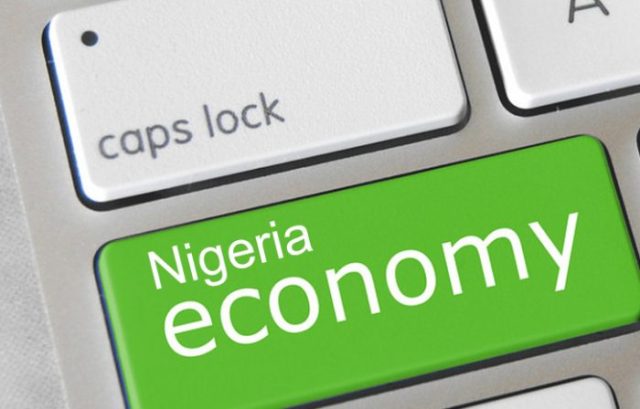Nigeria’s Macroeconomic situation 1Q 2021

The Monetary Policy Committee met for the second time in March 2021 and all rates were left unchanged. The Committee believes this policy posture would be desirable for the country’s recovery process.
The Prime Lending Rate (PLR) declined to 11.21% from 11.25% but Maximum Lending Rate (MLR) rose to 28.54% in February from 28.3% in January 2021.
The 270-day Treasury Bills (T-Bills) maintained their upward trajectory as the rate moved from 2.38% in February to 5.47% in March 2021.
Oil prices dropped slightly in March 2021 to $63.4 per barrel from $66.26 per barrel recorded in February 2021.
The slowdown in oil price comes as new movement restrictions have been enforced in Europe as the third wave of COVID-19 emerges.
Oil production cuts are expected to be extended as the economic environment remains challenging, complex and uncertain.
Inflation Rate (%) Inflation rate sustained its upward trend rising to 17.33% in February 2021 from 16.47% posted in January.
Food inflation maintains its surge dragging core inflation alongside. The food and core inflation rate rose to 21.79% and 12.38% in February 2021, respectively, from 20.57% and 11.85% posted in the previous month.
Insecurity in food-producing areas continues to affect food prices. Fuel and electricity tariffs hike and the depreciation of the Naira also added to driving core inflation upwards.
Forex Reserves: Forex Rate External reserves declined to $34.79 billion in March 2021 compared to $35.1 billion in February. NAFEX closed at N407.63/$ in March 2021 reflecting an N2.85 appreciation relative to the figure recorded in the preceding month.
The CBN introduced the “Naira 4 Dollar Scheme” in March. This is aimed at boosting the inflow of remittances into the country. The Government in March also moved the rate of official transactions to the rate prevailing at the NAFEX window from N379/US$ previously.
The Construction Industry in Nigeria
The Nigerian construction industry engages in a wide range of building and engineering activities and is made up of both local and foreign-owned construction companies. Data from the National Bureau of Statistics (NBS) reveals the total market size of the Nigerian construction industry to be approximately N11.64 trillion as of 2020.
Whilst construction services are demanded by both the Government and private individuals, the government remains the major driver of its demand as it tries to close the infrastructure deficit which is 40% of the GDP, to meet the international benchmark of 70% of the GDP. Private investors are also key players in the industry boosting the supply of construction services through the development of projects aimed at residential customers and corporate establishments.
Key drivers expected to contribute to the growth of the construction industry in coming years include Nigeria’s ever-growing population, rapid urbanization across the country, housing deficit of over 16 million units, Nigeria’s severe infrastructural gap amongst others. While these growth drivers are in place, weakened government finances weakened forex and insufficient Foreign Direct Investment (FDI) amongst others could inhibit the growth of the industry.
COVID-19 Impact on the Nigerian Construction Industry
Weak Public Finances: Government finance took a massive hit in 2020 as oil prices plummeted due to COVID. Oil revenue accounts for over 50% of the government revenue. The weakened public finances negatively impacted the construction industry as the government, which is a major driver for the demand of its services, had little to spend on capital expenditure.
GDP Contraction: The construction industry thrives when the economy is experiencing a boom due to demand driven by both public and private stakeholders. The GDP contraction in 2020 due to COVID-19 really hurt the industry.
Movement Disruption: The imposition of the lockdown to reduce the spread of the virus significantly disrupted the activities of this sector. The construction industry, which requires onsite physical presence with limited scope for digital completions of projects, was negatively impacted by the social distancing/lockdown measures.
Weakened Naira: Inadequate supply of the Dollar due to weak exports was matched with increased demand for the Dollar, thus weakening the Naira. Construction operators increasingly struggled to pay for its imports, thus increasing operational costs.
Weak Investor Sentiment: The COVID-19 pandemic dealt a huge blow on investor’s confidence. Capital importation into the country declined by 74.03% year-on-year in 2020.
Although the construction industry is not a large recipient of foreign inflows, inflow to other industries has a ripple effect on the industry. Poor capital import thus inhibited the growth of the industry.
Funding Constraints: The banking industry’s appetite to fund the construction industry remains low despite the CBN’s minimum Load to Deposit Ratio (LDR) regulation. The non-performing loan from the industry grew by 66.57% in 2019 reflecting a high-risk profile.
The Industry Post COVID-19
Recovering Economy: The Nigerian GDP growth rate moved from the negative space in Q4 2020 reflecting a recovering economy that was dealt a huge blow by the COVID-19 pandemic at the beginning of 2020. Pick-up in economic activities will be instrumental in boosting the growth of the construction industry in the coming quarters.
AFCFTA: The African Continental Free Trade Area (AfCFTA) would promote market expansion for businesses, job creation for the populace amongst others. The government is working to improve existing road networks and ports to benefit from the gain to the trade pact. This means more business activities for the construction industry.
Private Investment: As the residential and non-residential sector in Nigeria attracts private investment, the construction industry benefits from it. In the long run, a larger share of domestic and foreign investments in the construction sector will come from sources other than the oil Industry.
Improving Oil Prices: Oil prices have been on an upward trajectory just after a crash in its price in April 2020 due to the impact of COVID-19 on economic activities across the globe. Improving oil prices connotes more fiscal revenue for capital expenditure thus increasing the demand for the services from the construction industry.
Forex Supply: The forex supply of the dollar continues to outweigh its demand. The imbalance makes depreciation of the Naira inevitable leading to more Naira needed to exchange a dollar.
The latest CBN’s diaspora remittances policy amongst other forex driven policies are expected to ease out this imbalance.
Government Support: The government knows how the construction and rehabilitation would improve the ease of doing business in Nigeria. This means more demand for construction services. The government budgeted N100 billion in the Economic Sustainability Plan for new construction and rehabilitation.
According to Fitch, as rising oil prices and exports will enable greater public infrastructure investment and private investment in residential and commercial construction projects, Nigeria’s construction industry is forecast to gradually recover from the COVID-related 7.7% y-o-y contraction in 2020. The industry is expected to grow by 3.1% in 2021 and 3.7% in 2022.
In the long term, industry growth is expected to withstand the drag of stagnating oil prices and accelerate, fueled by improved non-oil government revenue collection, an increase of public debt-funded infrastructure investment, and a fast-growing private sector-led residential and non-residential building industry
Within Nigeria’s infrastructure sector, road and bridge construction is expected to benefit the most from increased oil prices and revenue, as this infrastructure sub-sector depends on public spending as enabled by government revenue. The road and bridge infrastructure sub-sector is forecast to grow by 3.8% in 2021, up from a previous forecast of 2.1%.
This long-term acceleration of residential and non-residential industry growth will be driven by decreasing inflation rates will, in turn, liberate household income and enable increased private consumption, contributing to growing investment in commercial as well as housing construction. Strong demand will be underpinned by Nigeria’s rising population growth.
The growing contribution of the private sector-led residential and non-residential building sector to Nigeria’s overall construction sector will compound the diversification of the construction industry’s investment sources away from oil income.
A decrease of the industry’s vulnerability to negative oil sector performance will improve long-term investor sentiment towards the construction sector.
Nigeria’s Macroeconomic Analysis
Nigeria exited a recession in FY 2020 following the reopening of global economies in Q3/Q4 2020, but most sectors remain in recession making the recovery fragile and unsustainable. This can be attributed to low GDP base from consistent contraction in previous quarters and supply jolt from oil receipts.
A commendable performance; however, it is void of real impact as Nigerians remain submerged in a recession since 2015 as the per-capital growth trend indicates; dipping lower than the 2016 position. A reversal of negative per capita.
GDP growth will require a consistent double-digit GDP growth rate in the medium term at least beyond the population growth rate.
Poor local consumption threatens economic growth and a galloping unemployment rate without investment opportunities deflates GDP per capita growth rate recovery aspirations.
Plenty of money but in few hands, as money circulation stalls
Money velocity measures the circulation/turnover of money in the economy highlighting the rate money circulates from household to household.
In 2020, Money velocity hit low levels (1.05x) lower than 2016 levels (1.12x) meaning money just circulates the economy once with a 5% chance of recirculation against a 12% chance in 2016. Despite the record money supply levels predicated on the huge stimulus rollouts and intervention funds; money decelerates.
Money velocity assessment provides valuable insights on Nigerians’ consumption and earnings rate in the local economy and dictates the direction of the economy. Higher velocity, More growth. Low velocity indicates increasing capital flight and FX holdings, Nigerians are saving more. The Stimulus is however not penetrating the real sector, as Nigerians are not spending due to earnings erosion, high unemployment and business contraction.
Inflation on the rise – FY 2021 Budget estimates will require an overhaul as macro developments decimate forecasts.
Inflation can be likened to an economic bacteria that slowly eats away value and disrupts plans if left unchecked.
Inflation is on the path to hit 20+% in 2021 which likely means that planned expenditures in 2021 budget preparations will be exceeded because the consensus inflation estimates were 17%. Businesses will have a large portion of their budgeted FY 2021 earnings (est. 20%) consumed by inflated expenses
Insecurity plaguing Nigeria has disrupted the food value chain, therefore, making food the major driver of inflation.
Inflation impedes consumption and low consumption impedes economic growth. Concerns centred on the ineffectiveness of security forces to combat insecurity during the rainy season as manoeuvrability is dampened and the inability to control the situation before the season commences will spike inflation further in H2 2021.
H2 historically has higher inflation due to the concentration of festivities. Fuel could further elevate inflationary pressures following de-subsidization.
Inflation will be further inflamed by Fuel Prices
Fuel pricing has a positive correlation with national inflation as it is a key input into the second-largest consumer expenditure class being Transport.
The discontinuation of fuel subsidization by the Federal Government means that fuel prices will have a positive correlation with global crude prices. The higher global crude prices, the higher domestic fuel price. The government has begun to proactively condition Nigerians into a N234 fuel price hike, an eventuality that will destabilize businesses plan for the year.
Nigeria, Africa’s largest crude producer, has the 10th largest crude reserves in the world, yet imports refined petroleum products and is reported to have spent at least N10 trillion (over US$26 billion) on subsidizing petroleum in 12 years.
Crude oil prices above the National 2021 budget of $40 automatically indicates a potential increase in fuel prices.
The ballooning debt profile and servicing requirements will stall per-capital growth recovery.
Survival quest, low-income base and inflation increases food consumption ratio
The high portion of food consumption in a Nigerian expenditure basket can be attributed to poor income, inflation and essentiality of food.
The pattern will remain largely the same in 2021 but we could see transport and food consumption ratio increasing further due to depressed wages and erosion, fuel de-subsidization characterized by developments in 2020.
Nigeria has an imbalanced consumption structure where food gulps 57%, thereby starving other sectors and development is hinged on the ability of consumers to increase local consumption in non-food sectors.
A population that is forced to consumes all it earns to survive submerges itself in the vicious cycle of poverty leaving the consumer with nothing to save nor invest in banks.
Rising inflationary pressures are driven by food inflation, unemployment will further erode Nigerians purchasing power depriving the Non-food sectors of consumption.
Remittances become a lifeline; elevating its value proposition
Remittances are increasingly serving as a secondary income for most Nigerians.
The impact of unemployment is being cushioned by the Nigerian diaspora population and domestic working population which plays a major stabilization role in Nigeria social-economic space.
54% of all Nigerian household receive a medium of remittance. 52.7% of Nigerian households received remittance from domestic sources while 5.7% receive remittance from international sources.
Data from the Nigerian Bureau of Statistics (NBS) showed that Edo state households received the most from international sources (25%) while Kebbi received the most from domestic sources. The increasing remittance rate constrains the domestic working class consumption capacity, erodes wealth creation and constrains growth.
Source: Access Bank Corporate Digest April 2021





